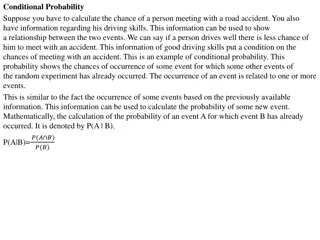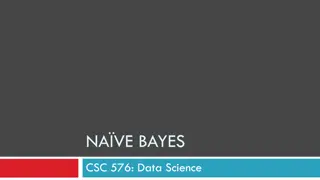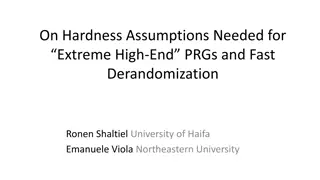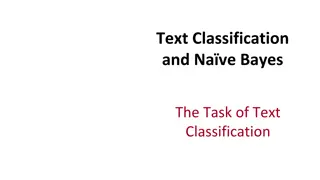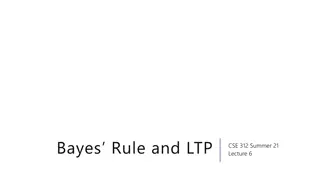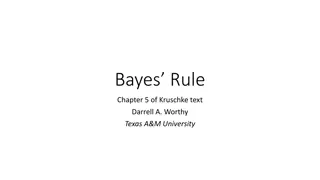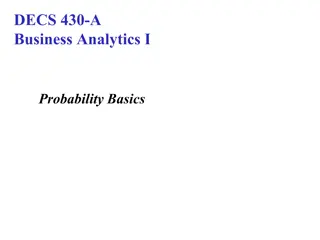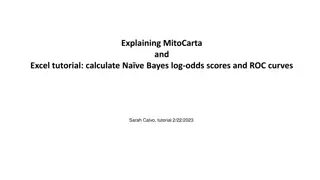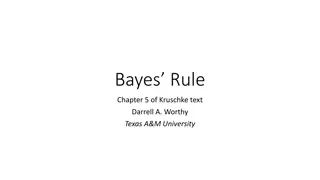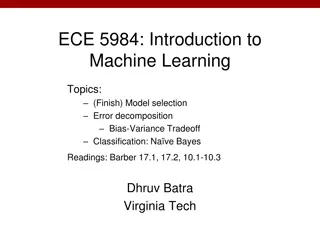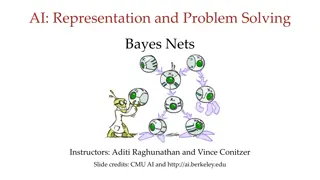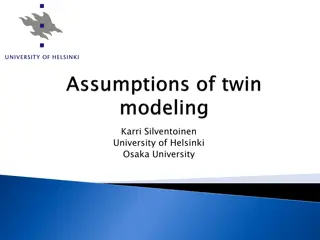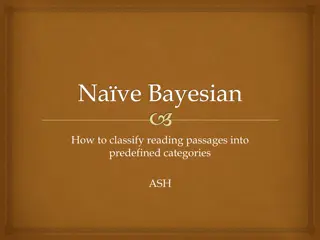Naive Bayes Assumptions and Rules
This content delves into the concept of Naive Bayes, discussing the assumptions made, zero counting, and basic rules such as the Product Rule, Sum Rule, and Normalisation Rule. It also provides examples and explanations on how to apply Bayes Rules for classification.
Download Presentation

Please find below an Image/Link to download the presentation.
The content on the website is provided AS IS for your information and personal use only. It may not be sold, licensed, or shared on other websites without obtaining consent from the author.If you encounter any issues during the download, it is possible that the publisher has removed the file from their server.
You are allowed to download the files provided on this website for personal or commercial use, subject to the condition that they are used lawfully. All files are the property of their respective owners.
The content on the website is provided AS IS for your information and personal use only. It may not be sold, licensed, or shared on other websites without obtaining consent from the author.
E N D
Presentation Transcript
COMP307 1 COMP307 Week 7 (Tutorial) Announcements - Assignment 2 Due: 23:59 Monday 8 May 2017 - Assignment 3 Due: 23:59 Monday 29 May Na ve Bayes - Assumption - Why not directly calculate ? ???? ???? ? - Zero counting Basic Rules Conditionally independent VS fully independent Bayes Rules
COMP307 2 Rules Product Rule: P(X,Y)=P(X)*P(Y|X) Sum Rule: Normalisation: Independence - P(X|Y) = P(X) - P(X, Y) = P(X) * P(Y)
COMP307 3 The Product Rule P(A)=7/18 A B C Y X P(X=T) = 9/18 9 T 4 2 3 P(X=T, Y=A) = 4/18 9 P(X=T|Y=A) = 4/7 T 3 3 3 P(Y=A|X=T) = 4/9 18 7 5 6 P(X=T, Y=A) = P(X=T)*P(Y=A|X=T) The Product Rule: P(X,Y)=P(X)*P(Y|X)
COMP307 4 The Sum Rule P(X=T, Y=A) = 4/18 A B C Y X P(X=T, Y=B) = 2/18 9 T 4 2 3 P(X=T, Y=C) = 3/18 9 P(X=T) = 9/18 T 3 3 3 18 7 5 6 P(X=T) = P(X=T, Y=A) +P(X=T, Y=B) +P(X=T, Y=C) The Sum Rule:
COMP307 5 The Normalisation Rule P(X=T) = 9/18 A B C Y X P(X= T) = 9/18 9 T 4 2 3 P(Y=A|X=T) = 4/9 9 P(Y=B|X=T) = 2/9 T 3 3 3 P(Y=C|X=T) = 3/9 18 7 5 6 P(X=T) +P(X= T) = 1 P(Y=A|X=T) +P(Y=B|X=T) +P(Y=C|X=T) = 1 The Normalisation Rule:
COMP307 6 Example Windy or Calm Day 1 >Day 2 P(D1=W) = 0.5 P(D1=C) = 0.5 P(D2=W|D1=W) = 0.6 P(D2=C|D1=W) = 0.4 P(D2=W|D1=C) = 0.3 P(D2=C|D1=C) = 0.7 Question: P(D2=W) ? Question: P(D3=W) ? Question: P(D3=C) ?
COMP307 7 Bayes Rules P(A,B) = P(A|B) P(B) We can also get: P(A,B)= P(B|A) P(A) Bayes Rules: More variables Thomas Bayes (/ be z/; c. 1701 7 April 1761)
COMP307 8 Bayes Rules for Classification Solution: First use Bayes Law/Rules, calculate the probability of given instance belong to a class: ? ???? ???? =? ???? ????? ?(?????) ?(????) For example: ? ?ej??? ??? = ???? & ??? = ?? & ??? = ? ?????? =?(??? = ???? & ??? = ?? & ??? = ? ?????? ?????? ?(?ej???) ?(??? = ???? & ??? = ?? & ??? = ? ??????) P(Reject|job=true & dep = high & fam=children) P(Accept|job=true & dep = high & fam=children) Choose the highest probability
COMP307 9 Na ve Bayes: Summary 1. Bayes Rules: 2. Classification: If Y is class label, X1 .. Xn features, the probability of an instance belong to a class is Too Hard 2. Assume features are conditionally independent: given Y, X1 .. Xn are independent to each other: ? ???? ???? =? ???? ????? ?(?????) Naive Bayes ?(????) Chose the highest probability/Score
COMP307 10 Bayes Rules for Classification ? ???? ???? =? ???? ????? ?(?????) ?(????) Why not directly calculate ? ???? ???? ? P(Reject|job=true & dep = high & fam=children) P(Accept|job=true & dep = high & fam=children)
COMP307 11 Computing Probabilities: Counting Occurrences Approve Reject Approve Reject P(Class) 5/10 5/10 Class 5 5 P(job=true|class) 4/5 2/5 Job=true 4 2 P(job=false|class) 1/5 3/5 Job=false 1 3 P(dep=low|class) 2/5 4/5 dep=low 2 4 P(dep=high|class) 3/5 1/5 dep=high 3 1 P(fam=single|class) 3/5 1/5 fam=single 3 1 P(fam=couple|class) 2/5 2/5 fam=couple 2 2 P(fam=children|class) 0/5 2/5 fam=children 0 2
COMP307 12 Using Naive Bayes Classifier P(Reject|job=true & dep = high & fam=children) P(job=true & dep = high & fam=children|Reject) P(Reject) P(job=true & dep = high & fam=children) = P (job=true|Reject) P (dep=high|Reject) P (fam=children|Reject) P(Reject) P(job=true & dep = high & fam=children) = 2/5 1/5 2/5 1/2 = ???? P(Accept|job=true & dep = high & fam=children) P(job=true & dep = high & fam=children|Accept) P(Accept) P(job=true & dep = high & fam=children) = P (job=true|Accept) P (dep=high|Accept) P (fam=children|Accept) P(Accept) P(job=true & dep = high & fam=children) = 0 = ????
COMP307 13 Dealing with Zero Counts Initialise table to contain small constant, e.g. 1 This is not quite sound, but reasonable in practice Approve Reject Approve Reject P(Class) 6/12 6/12 Class 6 6 P(job=true|class) 5/7 3/7 Job=true 5 3 P(job=false|class) 2/7 4/7 Job=false 2 4 P(dep=low|class) 3/7 5/7 dep=low 3 5 P(dep=high|class) 4/7 2/7 dep=high 4 2 P(fam=single|class) 4/8 2/8 fam=single 4 2 P(fam=couple|class) 3/8 3/8 fam=couple 3 3 P(fam=children|class) 1/8 3/8 fam=children 1 3 Compared with previous table, tricks here : job and dep: 5+2=7; fam has 5+3=8;
COMP307 14 Using Naive Bayes Classifier P(Reject|job=true & dep = high & fam=children) P(job=true & dep = high & fam=children|Reject) P(Reject) P(job=true & dep = high & fam=children) = P (job=true|Reject) P (dep=high|Reject) P (fam=children|Reject) P(Reject) P(job=true & dep = high & fam=children) = 3/7 2/7 3/8 1/2 18/784 = = ???? ???? P(Accept|job=true & dep = high & fam=children) P(job=true & dep = high & fam=children|Accept) P(Accept) P(job=true & dep = high & fam=children) = P (job=true|Accept) P (dep=high|Accept) P (fam=children|Accept) P(Accept) P(job=true & dep = high & fam=children) = 5/7 4/7 1/8 1/2 20/784 = = ???? ????
COMP307 15 Using Naive Bayes Classifier A and B independent does not imply and is not implied by A and B are conditionally independent given C
COMP307 16 Conditional independence Two random variables X and Y are conditionally independent given a third random variable Z if and only if they are independent in their conditional probability distribution given Z. That is: X and Y are conditionally independent given Z if and only if, given any value of Z, the probability distribution of X is the same for all values of Y, and the probability distribution of Y is the same for all values of X. X Y neither implies nor is implied by X Y | Z. - P(X, Y|Z) = P(X|Z) * P(Y|Z) - P(X|Z) = P(X|Y,Z)
COMP307 17 Independence VS Conditional Independence not R B, not R B| Y. P(B)=P(R)=13/36, P(B,R)=4/36 not equal P(B)*P(R) P(B,R|Y)=1/11, not equal P(B|Y)*P(R|Y)=3/11*3/11 R B, and R B | Y. P(B)=P(R)=12/36=1/3, P(B,R)=4/36, equal P(B)*P(R)=1/9 P(B,R|Y)=1/9 equal P(B|Y)*P(R|Y)=3/9*3/9 not R B, R B|Y. P(B)=P(R)=13/36, P(B,R)=4/36 not equal P(B)*P(R) P(B,R|Y)=1/9 equal P(B|Y)*P(R|Y)=3/9*3/9 R B, not R B | Y. P(B)=P(R)=12/36=1/3, P(B,R)=4/36, equal P(B)*P(R)=1/9 P(B,R|Y)=1/11, not equal P(B|Y)*P(R|Y)=3/11*3/11
COMP307 19 Conditional independence R B neither implies nor is implied by R B | Y. R and B are conditionally independent given Y, but not independent to each other Example 1: - Total possible outcomes = 7*7= 49 - P(R) = 16/49, P(B)=18/49, P(R,B)=6/49;;; P(R|B)=4/18 !=P(R) - P(R|Y)= 4/12, P(B|Y)= 6/12, P(R,B|Y)=2/12 Example 2: - Total possibilities = 6*6= 36 - P(R) = 13/36, P(B)=13/36, P(R,B)=4/36
COMP307 20 Conditional independence Two Example: Each cell represents a possible outcome. - The events R, B and Y are represented by the areas shaded red, blue and yellow respectively. - The overlap between the events R and B is shaded purple. - The probabilities of these events are shaded areas with respect to the total area. Both examples, R and B are conditionally independent given Y because: P(R,B/Y)=P(R/Y)*P(B/Y): [2/12=6/12 * 4/12 ] but R and B not conditionally independent given not Y because P(R,B/not Y) not equal to P(R/ not Y)*P(B/not Y) but R and B are not independent to each other







